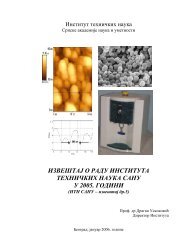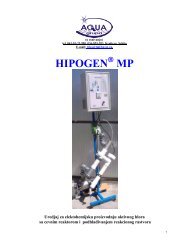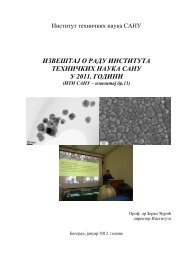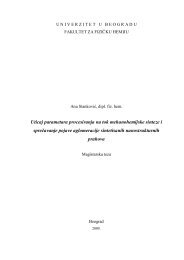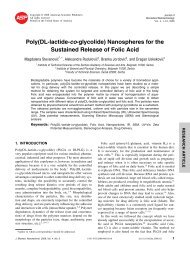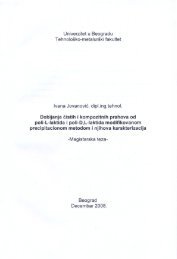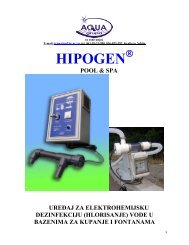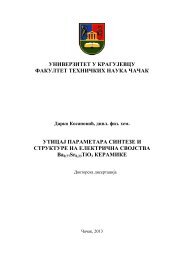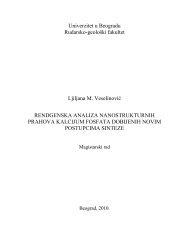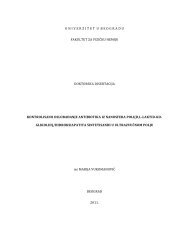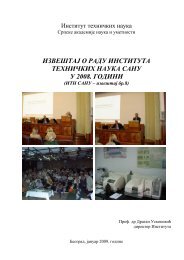Program and the Book of Abstracts (PDF) - Mrs-serbia.org.rs
Program and the Book of Abstracts (PDF) - Mrs-serbia.org.rs
Program and the Book of Abstracts (PDF) - Mrs-serbia.org.rs
Create successful ePaper yourself
Turn your PDF publications into a flip-book with our unique Google optimized e-Paper software.
Tenth Young Researche<strong>rs</strong> Conference – Materials Science <strong>and</strong> Engineering<br />
December 21-23, 2011, Hall 2, SASA, Knez Mihailova 35 & 36, Belgrade, Serbia<br />
VII/3<br />
A method for obtaining nanosized molybdenum powde<strong>rs</strong> from petrochemical<br />
industry wastes<br />
Ivan Mikhailov, Y. Konuhov, D. Ryzhonkov, M. Kostitsyn<br />
National Unive<strong>rs</strong>ity <strong>of</strong> Science <strong>and</strong> Technology “MISiS”, Moscow, Russia<br />
The aim <strong>of</strong> <strong>the</strong> presented work was to develop a method for producing molybdenum <strong>and</strong><br />
molybdenum trioxide nanopowde<strong>rs</strong> from spent hydrodesulphurization catalysts. The raw material,<br />
intermediate <strong>and</strong> final products was investigated by <strong>the</strong>rmogravimetry, secondary ion mass<br />
spectrometry, scanning electron microscope, <strong>and</strong> X-ray analysis.<br />
According to <strong>the</strong> developed method, molybdenum, molybdenum trioxide <strong>and</strong> alumina<br />
nanopowde<strong>rs</strong> were obtained with specified morphology <strong>and</strong> dispe<strong>rs</strong>ion. Output <strong>of</strong> molybdenum was<br />
more than 80 %. According to <strong>the</strong> X-ray analysis, in <strong>the</strong> final products wasn’t found no impurity<br />
phases.<br />
A character <strong>of</strong> <strong>the</strong> temperature dependence <strong>of</strong> molybdenum nanopowder specific surface area<br />
was shown.<br />
VII/4<br />
Photocatalytic efficiency <strong>of</strong> TiO 2 nanopowde<strong>rs</strong> prepared by sol-gel route in<br />
degradation <strong>of</strong> metoprolol in water suspension<br />
Sanja Armaković 1 , Biljana Abramović 1 , Maja Šćepanović 2 , Aleks<strong>and</strong>ar Golubović 2<br />
1 Department <strong>of</strong> Chemistry, Biochemistry <strong>and</strong> Environmental Protection, Faculty <strong>of</strong> Sciences,<br />
Unive<strong>rs</strong>ity <strong>of</strong> Novi Sad, Novi Sad, Serbia , 2 Institute <strong>of</strong> Physics, Unive<strong>rs</strong>ity <strong>of</strong> Belgrade, Belgrade,<br />
Serbia<br />
Nanocrystalline titanium dioxide (TiO 2 ) powde<strong>rs</strong> have been syn<strong>the</strong>sized by sol-gel method<br />
using titanium tetrachloride (TiCl 4 ) or tetrabutyl titanate (Ti(OC 4 H 9 ) 4 as precu<strong>rs</strong>o<strong>rs</strong>, different<br />
alcohols <strong>and</strong> calcination temperatures in <strong>the</strong> range from 400 to 650 o C. Syn<strong>the</strong>sized powde<strong>rs</strong> were<br />
tested for <strong>the</strong>ir photocatalytic activity in <strong>the</strong> degradation <strong>of</strong> metoprolol, a selective β-blocker used to<br />
treat a variety <strong>of</strong> cardiovascular diseases, <strong>and</strong> compared to photocatalytic activity <strong>of</strong> Degussa P25.<br />
Nanosized TiO 2 powde<strong>rs</strong> prepared from TiCl 4 <strong>and</strong> amyl-alcohol, calcinated at 550 o C, displayed an<br />
activity comparable to Degussa P25, whereas <strong>the</strong> sample from <strong>the</strong> same series, calcinated at 650 o C,<br />
showed a higher photocatalytic activity in <strong>the</strong> whole range <strong>of</strong> <strong>the</strong> catalyst loading.<br />
28





